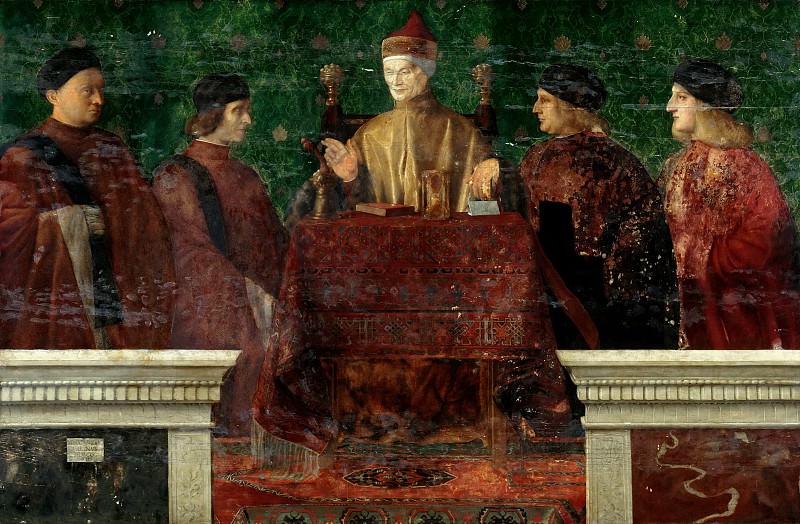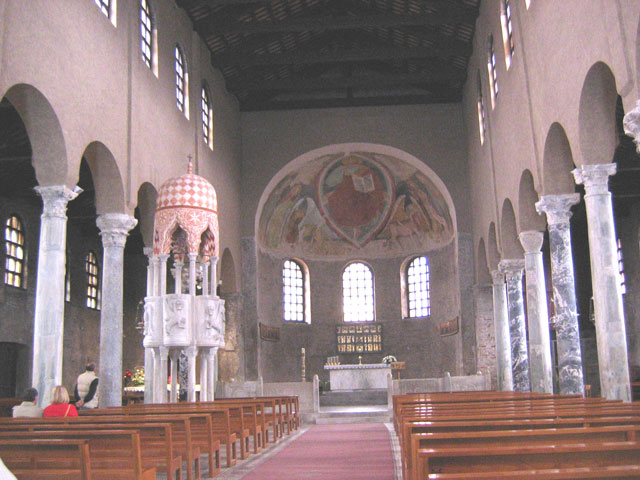|
Barozzi
The House of Barozzi was an aristocratic Venetian family that belong to the Venetian nobility. Members of the family became sailors, clerics and men of learning. They were lords of Santorini and Thirassia, and held military fiefs on the island of Crete. Members of the family were involved in the conspiracy of Bajamonte Tiepolo against the Doge of Venice in 1310. Notable members * Pietro Barozzi, who in 1192 led a Venetian naval expedition against the Republic of Pisa * Andrea Barozzi, his brother, who sailed with the Venetian contingent led by the Doge Enrico Dandolo in the Fourth Crusade * Benedetto, Marino and Pancrazio Barozzi, who obtained military fiefs in the Venetian colony of Candia on the island of Crete * Angelo Barozzi (died 1238), patriarch of Grado (now in Friuli-Venezia Giulia) from 1207 until 1237 * Iacopo Barozzi (died ''circa'' 1245), duke of Candia 1244–1245, who – according to tradition – in the aftermath of the sack of Constantinople in 1204 c ... [...More Info...] [...Related Items...] OR: [Wikipedia] [Google] [Baidu] |
Francesco Barozzi
Francesco Barozzi (in Latin, ''Franciscus Barocius'') (9 August 1537 – 23 November 1604) was an Italian mathematician, astronomer and humanist. Life Barozzi was born on the island of Crete, at Candia (now Heraklion), at the time a Venetian possession. He was the son of Iacopo Barozzi, a Venetian nobleman, and Fiordiligi Dorro. Barozzi was educated at Padua, and studied mathematics at the University of Padua. The estate on Crete, inherited from his father, yielded him an income of 4,000 ducats, though he seems to have lived in Venice for most of his life. He was thus able to function as an independent scholar, and does not appear to have held any academic posts, although he did lecture on the ''De sphaera'' of Sacrobosco at the University of Padua in 1559. Barozzi translated many works of the ancients, including Proclus’s edition of Euclid's Elements (published in Venice in 1560), as well as mathematical works by Hero, Pappus of Alexandria, and Archimedes. Ma ... [...More Info...] [...Related Items...] OR: [Wikipedia] [Google] [Baidu] |
Venetian Nobility
The Venetian patriciate ( it, Patriziato veneziano, vec, Patrisiato venesian) was one of the three social bodies into which the society of the Republic of Venice was divided, together with citizens and foreigners. was the noble title of the members of the aristocracy ruling the city of Venice and the Republic. The title was abbreviated, in front of the name, by the initials N.H. ( or ), together with the feminine variant N.D. (). Holding the title of a Venetian patrician was a great honour and many European kings and princes, as well as foreign noble families, are known to have asked for and obtained the prestigious title. The patrician houses, formally recorded in the Golden Book, were primarily divided into Old Houses () and New Houses (), with the former being noted for traditionally electing the first Doge in 697 AD. The New Houses were no less significant, as many became very prominent and important in the history of the Republic of Venice. The families were furtherm ... [...More Info...] [...Related Items...] OR: [Wikipedia] [Google] [Baidu] |
Andrea Barozzi
Andrea Barozzi () was a Venetian nobleman. He served as official and military commander for the Venetian Republic. Life Andrea was the firstborn son of Iacopo Barozzi, a Venetian official who was duke of Candia . Beginning with Karl Hopf in the 19th century, several modern historians held that Andrea's father had seized the Aegean islands of Santorini and Therasia following the Fourth Crusade, meaning that Andrea was the second lord of the island following his father's death , but this has been refuted in the later 1960s, when it was shown that Barozzi rule over Santorini can be documented only from the early 14th century on. In 1252, the Venetian authorities ceded Andrea Barozzi two knightly fiefs in the Venetian colony of Crete. In 1258–59 he held the high office of Bailo of Negroponte. At that time, he negotiated a treaty to end the War of the Euboeote Succession, between the Triarchs of Negroponte, who had been backed by Venice, and William II of Villehardouin, the Prince ... [...More Info...] [...Related Items...] OR: [Wikipedia] [Google] [Baidu] |
Iacopo II Barozzi
Iacopo, or Jacopo (II) Barozzi (died 1308), was a Venetian nobleman and the first lord of Santorini in the Cyclades. He also occupied several high-ranking colonial positions for the Venetian Republic. Life Iacopo Barozzi was the firstborn son of Andrea Barozzi, a Venetian official. Beginning with Karl Hopf in the 19th century, several modern historians held that his family had ruled the island of Santorini as a fief following the Fourth Crusade, meaning that Iacopo was heir to its lordship, but this has been refuted in the second half of the 20th century, when it was shown that Barozzi rule over Santorini can be documented only from the early 14th century on. Iacopo's early career was as a colonial administrator for the Venetian Republic in the Aegean: in the early 1290s he served as rector of Chania in the Venetian colony of Crete, then as Bailo of Negroponte from August 1295 to 1297, and finally as Duke of Candia in Crete from 1301 to 1303. At the same time, a council decid ... [...More Info...] [...Related Items...] OR: [Wikipedia] [Google] [Baidu] |
Andrea II Barozzi
Andrea II Barozzi (died 1334) was a Venetian nobleman and lord of Santorini in the Cyclades and Admiral of Romania. He succeeded his father, Iacopo II Barozzi, on the latter's death in 1308. His possession of Santorini and Therasia was confirmed by a treaty between the Republic of Venice and the Byzantine Empire in 1310. Ca. 1315 he was bestowed the title of " Admiral of the Empire of Romania", probably by the titular emperor Philip. In 1316, his possessions were raided by Turkish pirates. Around 1325, Barozzi came into conflict with the Duke of Naxos, Nicholas I Sanudo, over his feudal status: the Dukes of Naxos claimed suzerainty of Santorini as lords of the Cyclades archipelago, but the Barozzi had equally staunchly refused to accept such an obligation. Despite the mediation of Venice, the conflict turned into open war between the two. A renewed Venetian intervention in 1328 eventually brought about an armistice in 1331. Andrea II Barozzi died in 1334. His successor, Marino ... [...More Info...] [...Related Items...] OR: [Wikipedia] [Google] [Baidu] |
Iacopo Barozzi
Iacopo or Jacopo (I) Barozzi (died ) was a Venetian nobleman and official. He served as Duke of Candia for the Venetian Republic. Life Iacopo Barozzi was born in Venice, in the parish of San Moisè. Beginning with Karl Hopf in the 19th century, several modern historians held that in the aftermath of the Fourth Crusade, Iacopo seized the Aegean islands of Santorini and Therasia, ruling them as their lord until his death , when he was succeeded by his son, Andrea. This has been refuted in the later 1960s, when it was shown that Barozzi rule over Santorini can be documented only from the early 14th century on, with Iacopo's grandson, Iacopo II Barozzi. Iacopo was registered in the Great Council, he was Vassano's ambassador. In 1238, Iacopo Barozzi together with Romeo Querini concluded a treaty with al-Kamil, Saladin's nephew, that stipulated the construction of a fondaco for commercial exchanges and a mutual prohibition of acts of piracy against each other. He owned a house ... [...More Info...] [...Related Items...] OR: [Wikipedia] [Google] [Baidu] |
Francesco Barozzi (bishop)
Francesco Barozzi (died 1471) was a professor and a Roman Catholic prelate who served as Bishop of Treviso (1466–1471). ''(in Latin)'' Biography Francesco Barozzi was born in Italy. He taught law at the University of Padua from 1440 to 1466. On 17 April 1466, he was appointed during the papacy of Pope Paul II as Bishop of Treviso. On 6 July 1466, he was consecrated bishop by Gautier de Forcalquier, Bishop of Gap, with Placido Pavanello, Bishop of Torcello, and Nicolas de Crucibus Nicolas de Crucibus or Nicolò delle Croci (died 1473) was a Roman Catholic prelate who served as Bishop of Hvar (1463–1473) and Bishop of Chioggia (1457–1463). Biography On 21 October 1457, Nicolas de Crucibus was appointed Bishop of Chiogg ..., Bishop of Hvar, serving as co-consecrators. He served as Bishop of Treviso until his death in 1471. References External links and additional sources * (for Chronology of Bishops) * (for Chronology of Bishops) * 15th-centur ... [...More Info...] [...Related Items...] OR: [Wikipedia] [Google] [Baidu] |
Angelo Barozzi
Angelo Barozzi o Barocci (...-1237) was a Roman Catholic prelate. He was first priest of San Giovanni Elemosinario, then chaplain of St Mark's Basilica The Patriarchal Cathedral Basilica of Saint Mark ( it, Basilica Cattedrale Patriarcale di San Marco), commonly known as St Mark's Basilica ( it, Basilica di San Marco; vec, Baxéłega de San Marco), is the cathedral church of the Catholic Pa ... and ducal Chancellor. In August 1207 he was appointed patriarch of Grado. Notes Sources * External links * Patriarchs of Aquileia 13th-century Roman Catholic archbishops 13th-century Venetian people 1237 deaths Barozzi family, Angelo {{Italy-RC-clergy-stub ... [...More Info...] [...Related Items...] OR: [Wikipedia] [Google] [Baidu] |
Santorini
Santorini ( el, Σαντορίνη, ), officially Thira (Greek: Θήρα ) and classical Greek Thera ( English pronunciation ), is an island in the southern Aegean Sea, about 200 km (120 mi) southeast from the Greek mainland. It is the largest island of a small circular archipelago, which bears the same name and is the remnant of a caldera. It forms the southernmost member of the Cyclades group of islands, with an area of approximately 73 km2 (28 sq mi) and a 2011 census population of 15,550. The municipality of Santorini includes the inhabited islands of Santorini and Therasia, as well as the uninhabited islands of Nea Kameni, Palaia Kameni, Aspronisi and Christiana. The total land area is 90.623 km2 (34.990 sq mi). Santorini is part of the Thira regional unit. The island was the site of one of the largest volcanic eruptions in recorded history: the Minoan eruption (sometimes called the Thera eruption), which occurred about 3,60 ... [...More Info...] [...Related Items...] OR: [Wikipedia] [Google] [Baidu] |
Bailo Of Negroponte
The ''bailo'' and captain of Negroponte was the representative of the Republic of Venice stationed at Chalcis (Negroponte) on the island of Euboea. The ''bailo'' played an important role as the mediator between, and ''de facto'' overlord of, the triarchs of Euboea, who had their common residence in Negroponte. The triarchies were created by the division of the island between three rulers (triarchs) after its conquest following the Fourth Crusade (1204). The Venetian title ''bailo'' (plural ''baili'') derives from the Latin ''baiulus''. In English, it may be translated bailiff, or otherwise rendered as bailey, baili, bailie, bailli or baillie. List of ''baili'' :Notes: ''maggiore'' = "the elder"; ''q.'' = quondam = "son of the late" *1216–???? Pietro Barbo il Zanco *1222–1224 Benedetto Falier *1224–1252 ???? *1252–1254 Leone Sanudo *1254–1256 Paolo Gradenigo *1256–1258 Marco Gradenigo *1258 Tommaso Giustiniani *1258–1261 Andrea Barozzi *1261–1263 Andrea Barbari ... [...More Info...] [...Related Items...] OR: [Wikipedia] [Google] [Baidu] |
Patriarch Of Grado
This is a list of the Patriarchs of Grado (north-eastern Italy). '' Catholic-Hierarchy.org''. David M. Cheney. Retrieved September 25, 2016"Patriarchal See of Grado" ''GCatholic.org''. Gabriel Chow. Retrieved September 25, 2016 The patriarchate came into being when the schismatic Patriarch of Aquileia, Paulinus (557–569), moved to [...More Info...] [...Related Items...] OR: [Wikipedia] [Google] [Baidu] |



